 Image search results - "maiko" Image search results - "maiko" |

Maiko poses in front of the Naginata-boko float across the street in Kyoto
|
|

A real crowd pleaser. Thanks for posing!
|
|

Pagoda and maiko
|
|

Verse 2 Lyrics (Omatsu/Omi-Maiko) 二番の英訳(雄松"Pine trees are very green, on sands very white.
Omatsugasato is, a young maiden's home.
Bush of red camellia, hides her teary face.
She's weeping o'er a lost love, much too short to last.
松は緑に 砂白き
雄松が里の 乙女子は
赤い椿の 森蔭に
はかない恋に 泣くとかや
Matsu wa midori ni, suna shiroki
Omatsugasato no, otomego wa
Akai tsubaki no, morikage ni
Hakanai koi ni, naku toka ya
Omi-Maiko is still famous for white sand beaches and pine trees. In summer these beaches are cluttered with people trying to get a tan.
See more photos of Omi-Maiko here.
|
|

"Pine trees are very green, on sands very white." Omi-Maiko
|
|

White sands of Omi-Maiko (Omatsu), Otsu, Shiga
|
|

Ripples lap white sands of Omi-Maiko.
|
|

Pine trees at Omi-Maiko
|
|

Kyoto University Rowing Club arrive at Omi-Maiko in Aug. 2006 during their annual Lake Biwa rowing trip.
|
|

Omatsu "Famous Place" marker
|
|
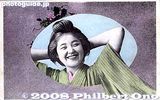
Out of all the geisha that have appeared on postcards, this ever-smiling geisha was unsurpassed in popularity. Her smiling visage appeared in 40 to 50 different poses in photographs and postcards made in Yokohama from the 1890s.
|
|

Her affable and infectious smile made her stand out during a time when most people posing for a photograph did not smile.
|
|
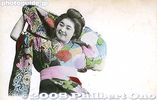
Her name has been a mystery, but I have come across hard evidence that she was a geisha named "Tokimatsu." But I will forever call her the "Laughing Geisha."
|
|
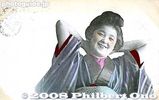
A saucy little Geisha. The pose is good.
|
|

Laughing Geisha with low neck. She's almost semi-nude. It is probably her sexiest pose of all. A great summertime card and one of my favorites. Hand-colored and postmarked Feb. 25, 1908 in Yokohama. The actual card is more yellowed.
|
|

Laughing Geisha with cowboy hat & cigar. This must be the most humorous pose she created. Those tourists must've gotten a big kick when they saw this card. A geisha from the wild, wild West. Even today, it elicits an affectionate laugh. One of my
|
|
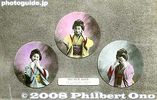
See, hear, nor speak no evil.
|
|
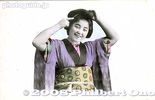
Combing her hair.
|
|
|

Laughing Geisha with fan. There are two Yokohama postmarks on this card. One in Japanese (over the stamp) and one in English. The actual card is more yellowed and almost brown, but I bleached it with Photoshop.There are two Yokohama postmarks on this card. One in Japanese (over the stamp) and one in English. Japanese postmarks have the date in the Year-month-day format. And English postmarks have it in the Day-month-Western year format. As you may know, Japan bases its years on the Emperor's reign. In the Japanese postmark, you can see "36" for the year. That's not 1936, but Meiji 36 that corresponds to 1903. Besides the Meiji Period (1868-1912), there's the Taisho Period (1912-1926) and the Showa Period (1926-1989). Since the Japanese postmark only indicates the last two digits of the year, it can be a pain to figure out which period the year belongs to. In most cases, we can figure it out with the stamp or type of postcard back.
|
|

Laughing Geisha on terrace. It looks like she's on the veranda of a restaurant along a river. If she's a Kyoto geisha, it would be the Kamo River. But these cards were made in Yokohama. I wonder if she was from Yokohama.
|
|

Laughing Geisha looking out. The card is postmarked 1903 from Yokohama. The actual card is more yellowed and almost brown, but I bleached it with Photoshop.
|
|

Laughing Geisha with baby. She's nicely posed, and you can even see the baby's face. But the color of her kimono is somewhat drab. A mother (or married woman) does not and need not wear a colorful kimono.
|
|

Laughing Geisha with umbrella. The sender probably wrote about his incredible adventures in Japan. Postmarked 1904 from Yokohama addressed to Hamburg, Germany. The actual card is more yellowed and almost brown, but I bleached it with Photoshop.
|
|

Laughing Geisha with umbrella. As you may have noticed, the umbrella (and fan) was a commonly used prop in tourist photos. Postmarked 1903 from Yokohama. The actual card is more yellowed and almost brown, but I bleached it with Photoshop.
|
|

Laughing Geisha in the rain. There's a horse in the background. Maybe she's watching a parade. The ground looks wet.
|
|

Laughing Geisha with Basket. It looks like she's dressed for picking tea leaves. This card, which has an undivided back, dates before 1907. The actual card is more yellowed.
|
|

Another shot of her picking tea leaves.
|
|
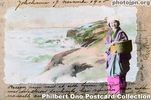
Laughing Geisha on Shore. It's kind of strange to see her at the beach but dressed to pick tea leaves. The message on this postcard was written in French, dated 1905.
|
|

Drawing water from a well.
|
|
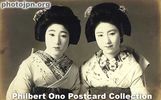
Pair of Geisha, autographed. One of my most treasured cards. This card was signed (on the chest area) by these two geisha with a fountain pen. Several other geisha also signed the back of the card. (See the next image.)
|
|
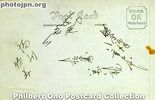
Pair of Geisha, autographed (back). This is the back of the preceding card. It looks like four geisha signed it.
|
|
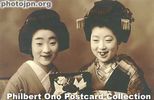
Geisha and maikoNot a good photo, but their names are written in hiragana on the back. They read "Suimatsu" on the left and "Shigezuru" on the right who is a maiko, not geisha. She has more ornaments in her hair than the geisha. Also notice their blackened teeth. If they are in Kyoto, a geisha is called "geiko." In Tokyo, a maiko (apprentice geisha) is called "hangyoku." This is a postcard-size photo and not a postcard.
|
|
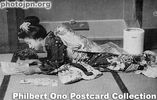
Maiko in Her RoomA private moment. This maiko is lying down in her kimono reading a comic book after getting tired of playing cards. Her mama-san probably would not be pleased to see her wrinkle the kimono like that. Not sure if this was staged or a candid shot. It's hard for anyone to lie down like that in a kimono.
|
|

Oiran courtesan. Also see my photos of an oiran show here. My oiran video at YouTube here.The highest-ranking geisha is called an oiran or tayu. She is escorted by two little attendant girls called kamuro. Notice her high clogs. It takes some skill to walk in those and she usually requires someone's shoulder to hold onto while walking. Sometimes at festivals or special events, you can see the Oiran Dochu procession where she walks in a parade together with geisha attendants.
|
|

Shin-Yoshiwara prostitutes. They are sitting behind the "cage" which fronted the street for all to see (and choose) within the licensed quarters. Shin-Yoshiwara was a famous red-light district of Tokyo. Note that they are not geisha.Geisha were not prostitutes. This photo was taken during 1907-1911. The woman in the far back was the brothel's matron who supervised this live display and everything else. In 1912 when Emperor Meiji died, this live display of women was later replaced by framed photographs of each woman hung near the brothel's entrance. In 1958, prostitution was outlawed in Japan, and Yoshiwara was history.
|
|
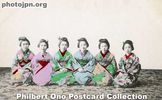
Brothel maids or prostitutes. Maids were employed to guide patrons to their rooms and serve sake and food. Or they could be low-class (cheap) prostitutes. Hand-colored, undivided back.
|
|

Geisha Pair Outside Geisha House. These two geisha know how to pose for the camera. It looks like Kyoto. You can tell that they are geisha because of the shorter kimono sleeve, subdued kimono design (mostly black), and their clogs (for rainy weather).
|
|

Patriotic Maiko. Card designed to encourage soldiers on the front line. Notice that her sleeves are so long that you can see her right sleeve touch the ground. That's the kimono of a maiko. This is a modern postcard reproduction.
|
|

Two Patriotic Maiko. To cheer up the soldiers on the front line, pretty and smiling maiko (apprentice geisha) often appeared on postcards for military mail. This card was postmarked Aug. 1940 from Shizuoka city. It was not addressed to a soldier though.Both women are maiko and not full-fledged geisha yet. The sleeves of a maiko's kimono reaches toward the ground as you can see here. (The sleeves of a geisha is shorter.) The kimono design is also more colorful and gaudy. Maiko also wear clogs called pokkuri. They are wedged at the front, so if you are not careful, you can trip forward. Geisha do not wear pokkuri.
|
|

Smiling Maiko Standing. Great smile. This is the same woman in the card where two maiko are holding the Japanese flag.
|
|

Smiling Maiko Sitting. Real-photo postcard to cheer up soldiers. This card was sent as military mail from Kyoto on New Year's Day 1939. The kanji characters on the fan says "Banzai," the traditional Japanese cheer for victory and happy occasReal-photo postcard to cheer up soldiers. This card was sent as military mail from Kyoto on New Year's Day 1939. The kanji characters on the fan says "Banzai," the traditional Japanese cheer for victory and happy occasions. It also means "long life," something that soldiers would like.
|
|

Laughing Maiko. Another card to cheer up the men at the front line.
|
|

Maiko hair ornaments. Maiko have more ornaments in their hair than geisha do. The hair ornaments differ depending on the current season. They usually have a flower motif, and if you look closely and see what flower it is, you can tell what season it is.
|
|

The maiko uses her real hair, not a wig. When her hair is down, it reaches her chest.
|
|

Smiling Maiko sitting in gardenNotice her left sleeve reaching the ground. A sign of a maiko's kimono, not a geisha's. Also, the high clogs that she wears are called pokkuri. Maiko wear them, but geisha do not.
|
|

Maiko on Gojobashi Bridge. Postcard-size real photo taken in Kyoto. She has been poorly posed. Her posture is bad, her kimono is ruffled, the sleeves look bad, and her feet are pointing in the wrong direction. Maiko usually know how to pose themselves.Postcard-size real photo taken in Kyoto. She has been poorly posed. Her posture is bad, her kimono is ruffled, the sleeves look bad, and her feet are pointing in the wrong direction. Maiko usually know how to pose themselves for a photograph. But not this one. Perhaps she's an amateur.
|
|

Maiko with umbrella. The quickest way to tell if she is a geisha or maiko is by looking at her back. The tell-tale sign of a maiko is her long obi sash hanging down behind. Whereas the geisha's sash has a short knot instead.
|
|

Canadian Peter MacIntosh is the Geisha Guru. He created a 13-meter-long montage of his Kyoto geiko/maiko photos. Ten years worth of 250+ photos.
|
|

Peter MacIntosh's Kyoto geiko/maiko photos. A few photos were taken overseas when he took a few geiko for overseas events.
|
|
|
|
|
|
|

Standing here felt like you were surrounded by geisha.
|
|

Peter MacIntosh explains his work to visitors. See Peter's Web site at petermacintosh.com.
|
|

Omi-Maiko Station on JR Kosei Line. It makes it easy for people in Kyoto to visit Omi-Maiko. MAPSign says "Welcome to Omi-Maiko." Omi-Maiko was in the former town of Shiga-cho that merged into Otsu.
|
|

Go left or right...Disobey the sign and go right to visit the main beach.
|
|

Go left to visit the hotel
|
|

Or go right to see the best beaches...
|
|

White sands at Omi-Maiko, Lake Biwa.
|
|
|
|

Great summer day for the beach at Omi-Maiko, one of the most popular and whitest beaches on Lake Biwa.
|
|
|
|
|

Clear waters and beautiful Lake Biwa beach at Omi-Maiko
|
|

Omi-Maiko
|
|

Green pine and white sand of Omi-Maiko, Lake Biwa.
|
|
|

Marker for OmatsuOmatsu is the old name for Omi-Maiko.
|
|
|

Monument for Lake Biwa Rowing Song (Biwako Shuko no Uta).In June 1917, a song called Biwako Shuko no Uta (Lake Biwa Rowing Song) was composed by college student Taro Oguchi during a boat rowing trip around Lake Biwa. He was a member of the rowing club at Dai-san High School (now Kyoto University). He composed it in Imazu, Shiga Prefecture during the second night of the trip.
The song is about the boys rowing around Lake Biwa while mentioning famous places like Otsu (the starting point), Omi-Maiko (Omatsu), Imazu, Chikubushima, Nagahama, and Chomeiji.
Another boat mate matched Oguchi's lyrics to the melody based on the old song called Water Lilies as modified by a young Chiaki Yoshida. It soon became a popular dormitory song.
|
|
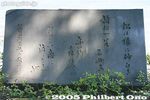
Monument for Lake Biwa Rowing Song (Biwako Shuko no Uta)The song became a national hit in 1971 when singer Tokiko Kato recorded it. Numerous famous Japanese singers and groups have since released cover versions of the song. The town of Imazu even holds an annual song contest in June when choir groups from around Japan sing the song in a competition. The town even has a museum dedicated to the song.
One of the verses mentions Omatsu (now called Omi-Maiko). This monument commemorates the song and that verse.
|
|

Manyoshu Monument
|
|

Monument for Biwako Hakkei. "Cool Breeze on White Sands of Omatsu" is one of the Eight Views of Lake Biwa as selected in 1949.
|
|
|
|
|
|

Omi-Maiko Beach Management Office
|
|

Goddess for lake safety
|
|

Attached lake behind the beach
|
|
|
|
|
|
|
|
|
|
|

Parking lot entrance
|
|

A little south of Omi-Maiko. Bicycled from Omi-Maiko and went south.
|
|
|
|
|
|
|
|
|
|